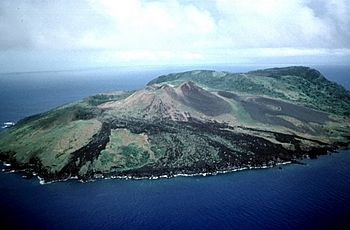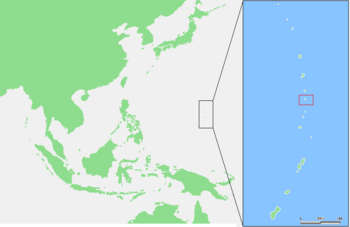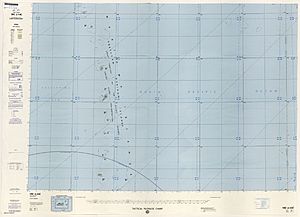Guguan facts for kids

US Geological Survey photo of Guguan
|
|
 |
|
| Geography | |
|---|---|
| Location | Pacific Ocean |
| Coordinates | 17°18′39″N 145°50′30″E / 17.31083°N 145.84167°E |
| Archipelago | Northern Mariana Islands |
| Area | 4 km2 (1.5 sq mi) |
| Length | 2.8 km (1.74 mi) |
| Width | 2.3 km (1.43 mi) |
| Highest elevation | 287 m (942 ft) |
| Administration | |
|
United States
|
|
| Commonwealth | Northern Mariana Islands |
| Demographics | |
| Population | - uninhabited - (2010) |
Guguan is a small island in the Northern Mariana Islands, located in the Pacific Ocean. This island has no people living on it. Guguan is about 30 miles (48 km) south of Alamagan island. It is also about 250 miles (402 km) north of Saipan.
Contents
History of Guguan Island
Early Discoveries and Naming
A Spanish missionary named Diego Luis de San Vitores found Guguan in 1668. He named the island San Felipe. It's possible that a Spanish sailor, Gonzalo de Vigo, visited it even earlier in 1522. He was part of the Ferdinand Magellan expedition.
Changing Control of Guguan
Unlike other islands nearby, Guguan was never settled by people. In 1899, Spain sold Guguan to the German Empire. It became part of German New Guinea. From 1909 to 1912, a Japanese company rented the island. They sent people to collect bird feathers. These feathers were used to make hats in Europe.
During World War I, Japan took control of Guguan. After the war, it was managed as the South Seas Mandate. This meant Japan looked after it. After World War II, the United States took control. It was part of the Trust Territory of the Pacific Islands. Since 1978, Guguan has been part of the Northern Mariana Islands. It is managed by the Northern Islands Municipality.
Geography of Guguan Island
Guguan island is mostly round. It is about 2.8 miles (4.5 km) long and 2.3 miles (3.7 km) wide. The island covers an area of about 3.87 square miles (10 sq km).
Volcanoes on Guguan
The island has two stratovolcanoes. These are tall, cone-shaped volcanoes. The southern volcano is 287 meters (942 feet) high. The northern volcano is 263 meters (863 feet) high. The northern volcano had an eruption around 1883. This eruption sent out hot ash and gases, called pyroclastic flows. It also produced lava flows that reached the ocean.
Coastline Features
The coast of Guguan has steep rocks. These rocks are made of basalt. There are also high ridges with deep valleys. Rain has carved these valleys over time.
Environment and Wildlife
Guguan as a Nature Preserve
In the early 1980s, Guguan became a nature preserve. This means it is protected to keep its natural environment safe. No humans have ever lived there permanently. This has helped keep the island free from animals that don't belong there. These include animals like cats, goats, pigs, and rats.
Important Bird Area
Guguan is a very important place for birds. BirdLife International has named it an Important Bird Area (IBA). This is because many special birds live and breed there.
Rare and Unique Birds
One rare bird found on Guguan is the Micronesian megapode. This bird lives only in the Northern Marianas and the Palau Islands. Other birds that call Guguan home include:
- White-throated ground doves
- Sooty terns
- Grey-backed terns
- Micronesian myzomelas
- Micronesian starlings
These birds help make Guguan a unique and important place for wildlife.
See also
 In Spanish: Guguan para niños
In Spanish: Guguan para niños


